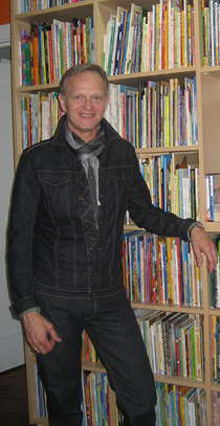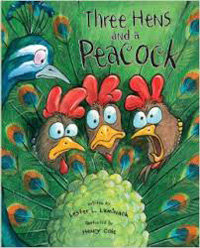 Lester L. Laminack has used every facet of his life as inspiration for writing. From his grandmother’s teacake recipe to his time in the classroom, he has crafted fiction and professional development work. Focused heavily on using read-alouds in different contexts, Laminack’s books teach students “the music in language” and teachers how to use texts to illuminate serious issues like bullying in school.
Lester L. Laminack has used every facet of his life as inspiration for writing. From his grandmother’s teacake recipe to his time in the classroom, he has crafted fiction and professional development work. Focused heavily on using read-alouds in different contexts, Laminack’s books teach students “the music in language” and teachers how to use texts to illuminate serious issues like bullying in school.
In July, Laminack will be at the ILA 2015 Conference where he will be a part of a Teaching Edge session on using mentor texts. Here, he talks about his inspiration and how he makes his fiction great read-aloud material.
You’ve often discussed the importance of read-alouds in school. Do you write with that in mind?
I am very conscious of rhythm and phrasing as I write. All through the development of a story, I pause to read and reread and read aloud. I listen for the sounds of words hanging together. I listen for those places where the balance is off, where the music in language just doesn’t resonate. I read with attention to how those words feel in my mouth, noting where I stumble or have to pause when reading aloud. Reading and listening to my own writing is one of my most frequently used revision tools.
What is it about read-alouds that gets children interested in independent reading?
Reading aloud to children is one way of making numerous deposits into the account they will draw from across their lives. It fills their ears with the music of written language, attuning the ear to the rhythms, pacing, and flow of language used in story, essays, expository material, and every other type of text. Reading aloud broadens vocabulary, develops familiarity with the arc of a story, the patterns of beginning, middle, and end, the development of a character. It creates a sense of kinship among those who share the story. Reading aloud to students exposes them to the structure of an essay, the framework for an argument, the reflection of a memoir. It is an engaging and non-threatening way to expose children to various genres, authors and purposes for reading. When a text is delivered on the voice of one who is passionate about language and writing and reading and teaching, the result is a powerful current that pulls anyone within earshot of the banks of onlooking into the flow of language. I believe that experience is necessary to the development of independent readers.
How has your work in the classroom affected your children’s books?
I was an elementary classroom teacher and a Title I reading teacher before I was a college professor, and I think of myself as a teacher who happens to be a writer. As a teacher, I have knowledge of the growth and development patterns in children and youth. I believe that helps to keep me focused on what and how children make sense of experience. And while that clearly rests in my conscious mind, it doesn’t constrict or define parameters for me. Perhaps it comes from that academic background, but I believe the more powerful influence is that I have somehow kept alive the child within.
Do you sit down with a particular lesson in mind or does the plot just lead to the lesson (envy in Three Hens and a Peacock, for instance)?
 I believe my best writing emerges and is fed by the process of allowing a story to grow. I have attempted to begin with a “lesson” in mind and it always fails. When I have taken that stance, the story builds to a point and implodes beneath the weight of that heaviness. There is one particular story I ache to tell and the primary problem with every draft I’ve made is that I am being guided by a particular “lesson” when I need to be guided by the character and let the story emerge. I have learned that the story works better when I give the characters enough room to live in my head and just follow them around taking notes.
I believe my best writing emerges and is fed by the process of allowing a story to grow. I have attempted to begin with a “lesson” in mind and it always fails. When I have taken that stance, the story builds to a point and implodes beneath the weight of that heaviness. There is one particular story I ache to tell and the primary problem with every draft I’ve made is that I am being guided by a particular “lesson” when I need to be guided by the character and let the story emerge. I have learned that the story works better when I give the characters enough room to live in my head and just follow them around taking notes.
We saw a photo of you in front of a very large, jam-packed bookshelf. Is that really yours, and if so, how are the books organized?
Yes, that photo was taken in 2010 in my old loft in downtown Asheville [North Carolina]. I’ve moved since then, but had similar shelving built in the new place so all my friends could come along. Regarding the system for organizing, anyone who knows me well understands my need for organization (I can hear a few of my friends chuckling as they read this). These books are organized in two ways. The majority of these books are shelved alphabetically by author’s last name. I also have several subsets organized by category or topic (bats, honeybees, civil rights, the Holocaust, kindness, etc.) because I work with them frequently and need to pull a collection for some purpose.
Laminack, along with Ruth Culham and Kate Messner, will host a Teaching Edge session Saturday, July 18 at the ILA 2015 Conference in St. Louis. Entitled “The Writing Thief: Using Mentor Texts to Teach the Craft of Writing,” the session will be based on Culham’s book, The Writing Thief, and the other presenters’ experiences as authors and educators. Visit the ILA 2015 Conference website for more information or to register.